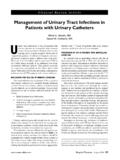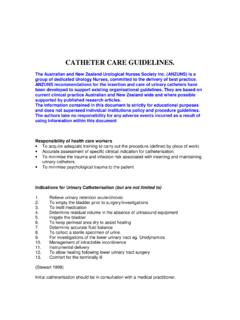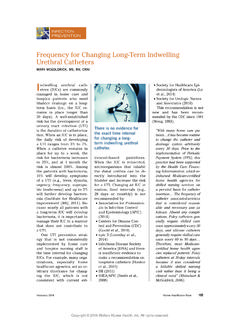Transcription of Management of urethral catheters: frequently …
1 Patient Information Department of Urology 24/Info_04_11 Management of urethral catheters Page 1 of 6 Management of urethral catheters: frequently -asked questions What is a catheter ? Your doctor has advised that you require a catheter inserted into your bladder to drain urine from it. A catheter is a small, flexible tube that is inserted through the water pipe (urethra) into the bladder to drain urine into a bag which is usually strapped to your leg. When the bag becomes full of urine, it will need to be emptied by opening the tap at the bottom of the bag either over the lavatory or into a suitable receptacle. The common type of catheter contains latex.
2 If you have any history of latex allergy, please ensure that the urology staff are informed of this before a catheter is inserted. In patients with latex allergy, an all-silicone catheter will be used because it carries no risk of an allergic reaction. The catheterisation will be performed by either a doctor or a nurse who will explain the reason for the catheter and whether it needs to be a permanent part of your lifestyle or, perhaps, only a temporary measure. The catheter will feel strange at first and you will certainly feel conscious of it, constantly feeling that you want to pass urine. This sensation, however, is quite normal and will soon pass.
3 How do I look after the catheter ? The catheter must be treated as a part of your own body and will need to be kept clean in the same way. It can be washed each day with warm, soapy water, Management of urethral catheters Page 2 of 6 either in the bath or in the shower, at the same time as you wash yourself. You are advised to wash the catheter away from the urethra so as not to encourage germs to enter the body and cause infection. Whilst you are using the catheter , you will need to drink plenty of fluids in order to prevent urinary infections and constipation. You should also take care not to kink the catheter or to raise the drainage bag above the level of your bladder.
4 Once your catheter has been inserted, the nurse looking after you will give you any additional information that you require, together with any spare equipment you may need. Once your GP has been notified of the catheter , your additional equipment can be bought on prescription which you should be able to obtain from your local chemist in the usual way. While at home, you will need to care for the catheter and drainage system. The different component parts of this are: The catheter You need do nothing to the catheter apart from keeping it clean on the outside by carefully washing yourself and the catheter tube itself. Ensure that you dry yourself gently and thoroughly to prevent soreness.
5 The leg-bag for daytime use This is attached directly to the catheter tube and will collect all the urine produced during the day. It will, of course, become heavier as it fills so do not allow it to become too full as this carries the risk of pulling out the catheter . Always wash your hands before and after using the tap on the end of the bag to empty urine into the toilet The leg-bag support This is rather like a footless sock and is used to keep your leg-bag securely attached to your leg. The G-strap This prevents the catheter from being pulled. It has a Velcro strap around the catheter and your leg to hold the catheter firmly in position. The night drainage bag This is connected directly to your leg-bag at night without disconnecting the leg-bag.
6 To connect the night drainage bag: remove the leg-bag support wash your hands carefully empty the leg-bag and, with the tap still open, push the end of the night bag into the small piece of tubing at the end of the tap. This should form a direct route for urine to collect in the night bag attach the night bag to its stand; this stays on the floor by the side of your bed Management of urethral catheters Page 3 of 6 in the morning, turn off the tap at the bottom of the leg-bag. disconnect the night bag, empty the urine into the toilet and rinse the night bag through with warm water. It is then ready to be used again the next night You will be sent home with a small supply of leg and night bags.
7 These should be changed only once a week unless there is a problem with one of them. If you have to dispose of your bag, it should be rinsed out with water, put into a plastic bag and put out with your normal household waste. What if I experience problems? Some problems may occur when you have a catheter but your District Nurse, GP or Nurse Practitioner can advise you on what action to Bladder spasms Bladder spasms feel like abdominal cramp and are quite common when you have a catheter in your bladder. The pain is caused by the bladder trying to squeeze out the balloon. If you are unable to tolerate this sensation, your GP can prescribe a drug such as Oxybutynin, Solifenacin or Tolterodine which stops the cramps.
8 Leakage around the catheter This is called by-passing. It is sometimes the result of bladder spasms or can take place when you open your bowels. If it does happen, please check that your urine is still draining. If it is not, you need to contact your District Nurse as soon as possible. Blood or debris in the urine This is common with a catheter . It is only of concern if you see large clots or solid pieces of debris passing down the catheter . If this happens, please contact your Nurse Practitioner for advice as this may cause a blockage. Blockage This will become an emergency situation if not dealt with in a timely fashion. Check that the drainage bag is below the level of your bladder, that the catheter has no kinks or twists in it, that there are no clots or debris in the catheter and that you are drinking enough.
9 If the catheter will not unblock, contact your District Nurse immediately or get in touch with your Nurse Practitioner. catheter falling out If your catheter falls out, contact your District Nurse or Nurse Practitioner immediately. If there is doubt about whether your catheter should be replaced, this will be discussed with the on-call urologist. Management of urethral catheters Page 4 of 6 Urine infection Infection is invariably found in the urine after catheterisation so a positive urine culture for bacteria is very common once a catheter has been in for more than 10-14 days; it does not necessarily mean that you need to take antibiotics.
10 However, if you have cloudy urine, cystitis (a burning sensation), unpleasant smelling urine or a high temperature, contact your GP immediately to determine whether you should have antibiotic type of catheter do I have? Type of catheter : Balloon size: Date of insertion: Date for catheter change: Clinic follow-up arranged: Type of leg-bags: Night bags given: GP/District Nurse informed: Y / N Name & signature of nurse: .. Who can I contact for more help or information? Oncology Nurses Uro-Oncology Nurse Specialist 01223 586748 Bladder cancer Nurse Practitioner (haematuria, chemotherapy & BCG) 01223 274608 Prostate cancer Nurse Practitioner 01223 274608 Non-Oncology Nurses Urology Nurse Practitioner (incontinence, urodynamics, catheter patients) 01223 274608 or 586748 Management of urethral catheters Page 5 of 6 Patient Advice & Liaison Centre (PALS) Telephone +44 (0)1223 216756 or 257257 +44 (0)1223 274432 or 274431 PatientLine *801 (from patient bedside telephones only)

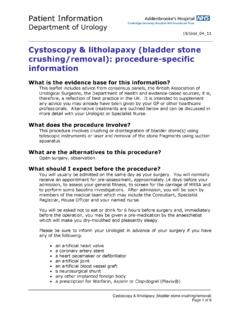

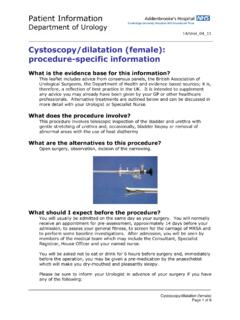

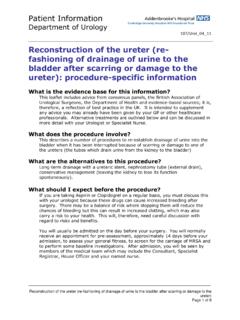
![Index [www.anzuns.org]](/cache/preview/e/5/e/3/7/9/a/a/thumb-e5e379aa8a69f70103ce934b4a1e24f2.jpg)


